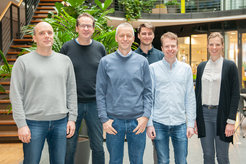Max Planck/Fraunhofer cooperation project ‘Snifits4Health’ started
Development of a portable measuring device for quantifying metabolite concentrations in the blood within minutes
Snifits4Health - an idea that originated in May 2019 and is now to be implemented in a product. The project is based on the idea of the biosensors "Snifits" for the simple measurement of various metabolites in the blood. Kai Johnsson, Director of the Department of Chemical Biology at the MPI for Medical Research, and colleagues demonstrated their use in 2018 in the journal Science (Link press release): A droplet of blood is first taken from the patient through a painless finger pick. In a second step, a fraction of the blood sample is added to a reaction buffer and applied onto a paper containing the immobilized biosensor. Depending on the concentration of the metabolite, the light emitted by the sensor changes its color from blue to red, which can be detected by a simple digital camera or a smartphone. (Figure 1)

For the development of a portable device on this technical basis, the scientists of the MPI for Medical Research have now teamed up with colleagues at the Fraunhofer Institutes for Cell Therapy and Immunology (IZI) and for Applied Optics and Precision Mechanics (IOF). "We have the expertise for the required optimization of the biosensors, but we rely on experts from other fields to make the sensor usable in an automated measuring device," says Dr. Corentin Gondrand, postdoctoral researcher at the MPI for Medical Research and project coordinator. The group around Dr. Dirk Kuhlmeier at the IZI brings the expertise in the field of microfluidics for diagnostic applications. They will be working on how to dilute the blood sample and apply it to a custom-made disposable chip for measurement in the device. The group of Dr. Norbert Danz at IOF will focus on the development of the optical tools for measuring the intensity of the biosensor on the chip.

The Snifits4Heath team (from left to right): Norbert Danz (Fraunhofer IOF), Dirk Kuhlmeier (Fraunhofer IZI), Kai Johnsson (MPI for medical research), Stephan Schake (Fraunhofer IOF), Corentin Gondrand (MPI for medical research), Elisabeth Wenzel (Fraunhofer IZI)
It remains to be shown how the measuring device will actually look like in the end and which functions can be implemented. "We have different ideas for implementing individual steps. As a team, we will have to test and evaluate them again and again,” says Dr. Gondrand. “Ultimately, we want to bring a device to market that can perform reliable measurements, is patient-friendly and inexpensive.” The team wants to create added value for the diagnosis and therapy of various diseases. If the implementation for the three selected analytes is successful, the technology could also be adapted for other substances. "Demonstrating the feasibility of our approach for these examples will open up a lot of opportunities" says Kai Johnsson, Director of the Department of Chemical Biology at the MPI for Medical Research and project partner. The scientists further plan to develop chips capable of recording and measuring different substances simultaneously in the blood.
The project will initially run for a period of four years. Snifits4Health is funded by the Max Planck Society and the Fraunhofer society.

